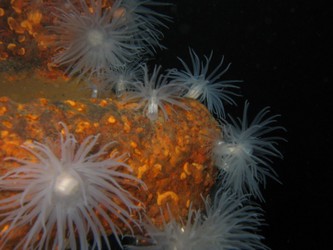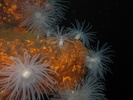Protantheae
Introduction
Carlgren's catalog (1949) recognized one family of Protantheae, the Gonactiniidae, containing the two genera Protanthea and Gonactinia.Characteristics
Protantheae: Actiniaria without basilar muscles or ciliated tracts. Column with longitudinal muscles and spirocysts.Gonactiniidae: Protantheae with flattened, disc-like proximal end. Column of the same structure as the tentacles with spirocysts and a more or less strongly developed longitudinal muscle layer, not capable of involution. No distinct sphincter. Tentacles not retractile. Longitudinal muscles of tentacles and radial muscles of oral disc ectodermal. Actinopharynx with longitudinal muscles and often with spirocysts, with weak siphonoglyphs. Mesenteries typically arranged in cycles, each pair, except the directives, with the longitudinal muscles facing each other. 8 mesenteries, the two pairs of directives and on each side 2 single mesenteries whose retractors face the ventral directives, perfect. Owing to asexual reproduction some more mesenteries may be perfect. Gonads usually on all perfect mesenteries. Ciliated tracts of the filaments absent. Cnidom: spirocysts, atrichs, basitrichs, microbasic p-mastigophors, microbasic amastigophors.
References
Carlgren, O. 1949. A Survey of the Ptychodactiaria, Corallimorpharia and Actiniaria. Kungl. Svenska Vetenskapsakadamiens Handlingar, series 4, volume 1, number 1.
Title Illustrations

| Scientific Name | Protanthea simplex |
|---|---|
| Location | Selma, Nesodden, Norway |
| Specimen Condition | Live Specimen |
| Source | Sealoch Anemone / Korallnellik (IMG_4030) |
| Source Collection | Flickr |
| Image Use |
 This media file is licensed under the Creative Commons Attribution-NonCommercial-NoDerivs License - Version 2.0. This media file is licensed under the Creative Commons Attribution-NonCommercial-NoDerivs License - Version 2.0.
|
| Copyright |
© 2005 Asbjørn Hansen

|
About This Page
The information provided on this page is based on Oscar Carlgren's 1949 catalog.Copyright © 1949 Swedish Academy of Sciences.
Please note that Carlgren's text contains a number of errors, and much of the information is now out of date. An update of the catalog is currently under preparation in Daphne Fautin's laboratory, and the results of this work will be incorporated in future versions of this page.
Keyboarding of Carlgren's catalog was done as part of a project to create an electronic database of the sea anemones of the world, funded by NSF Grant DEB9521819, awarded to Daphne G. Fautin. This grant is in the program Partnerships to Enhance Expertise in Taxonomy (PEET). Susanne Hauswaldt, Katherine Pearson, and April Wakefield-Pagels contributed to the keyboarding effort.
Correspondence regarding this page should be directed to Daphne G. Fautin at
fautin@ku.edu
Page copyright © 2000
All Rights Reserved.
Citing this page:
Tree of Life Web Project. 2000. Protantheae. Version 01 January 2000 (temporary). http://tolweb.org/Protantheae/17671/2000.01.01 in The Tree of Life Web Project, http://tolweb.org/








 Go to quick links
Go to quick search
Go to navigation for this section of the ToL site
Go to detailed links for the ToL site
Go to quick links
Go to quick search
Go to navigation for this section of the ToL site
Go to detailed links for the ToL site